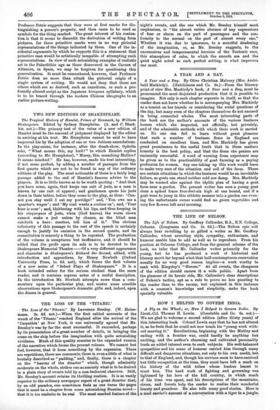THE FORMATION OF THE ALPHABET.
The Formation of the Alphabet. By W. M. Flinders Petrie. (Macmillan and Co. Oa net.)—Recent discoveries in the field of epigraphy, and especially the excavations of Professor Flinders Petrie and his assistants in Egypt, have thrown the gravest doubts upon the accepted views on the origin of the alphabet Professor Petrie's absorbingly interesting monograph, which is issued by the British School of Archaeology in Egypt, sets out very clearly the objections to the orthodox beliefs upon the sub- ject. The traditional theory, of course, traced the alphabet to the Phoenicians, and it was supported by Rough's suggestion that the Phoenicians bad derived their system from the Egyptian hieratic —the cursive form of hieroglyphic. This hypothesis, accepted cheerfully by Isaac Taylor and almost every other authority of a generation ago, seemed as satisfactory as possible. From the Egyptian picture-writing and its corrupt descendant the Phoenicians constructed their small and definite alphabet. Out of this, in turn, were developed, by means of enlargements and cor- ruptions determined by local needs, the numerous other alpha- betic systems which are known to us. Professor Petrie produces what seem to be conclusive arguments against this hypothesis. He puts forward, as the far more probable alternative, the theory that in primitive times a widely spread body of signs came into
existence for various purposes. These were spread about and interchanged through trade, and were eventually (by the action of selection) sifted down and systematised into a fixed alphabet,
with, however, local survivals and differentiations. It would be impossible to follow Professor Petrie's arguments in detail.
Generally it may be said that his evidence consists of cases
in which the same additions to, or variations from, the Phoenician alphabet are found in places widely separated geographically— cases which, consequently, suggest very strongly derivation from
an earlier source other than the Phcenieian. But the most im- portant argument of all is the fact of the existence in Egypt of
a large majority of the alphabetic signs in prehistoric times—that is, long before the beginning of hieroglyphic writing. The use of these signs at this early date can clearly not have been alphabetic. Professor Petrie suggests that they were at first marks for dis- tinguishing a person's property, and then came to be used as symbols for the thing marked. The great interest of his conten- tion is that it seems to discredit the derivation of writing from pictures, for these primitive marks were in no way pictorial representations of the things indicated by them. One of the in- cidental arguments by which he supports this is a statement that primitive man would be artistically incapable of attempting such representations. In view of such astonishing examples of realistic art in the Palaeolithic age as those discovered in the Cavern of Altamira, in Spain, we may be forgiven for questioning this generalization. It must be remembered, however, that Professor Petrie does no more than attack the pictorial origin of a single system of writing. He would not deny that there are others which are so derived, such as cuneiform, or such a pro- foundly altered script as the Japanese hiragana syllabary, which is to be traced through the modern Chinese ideographs to an earlier picture-writing.



































































 Previous page
Previous page